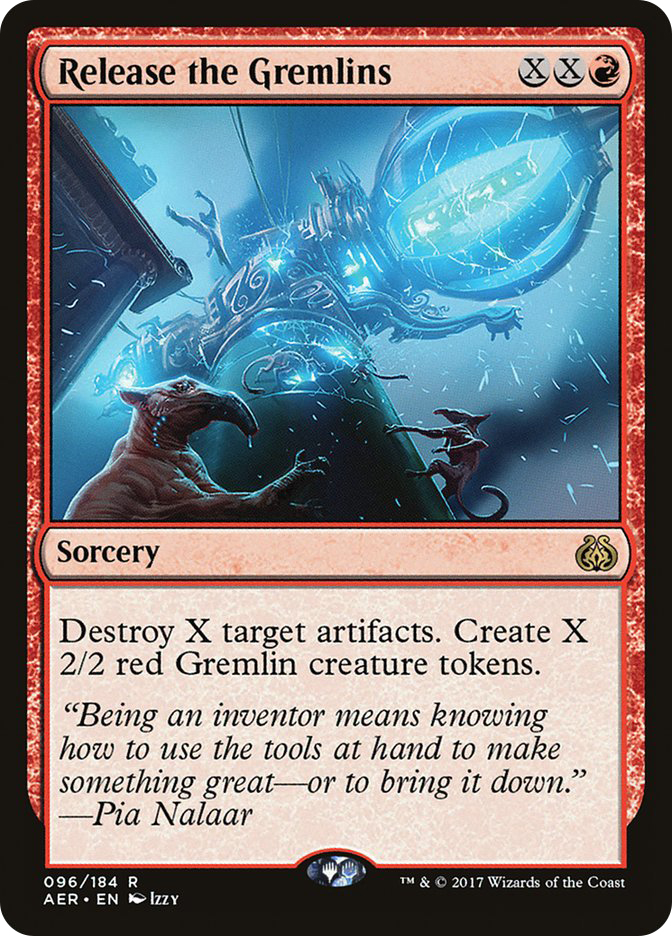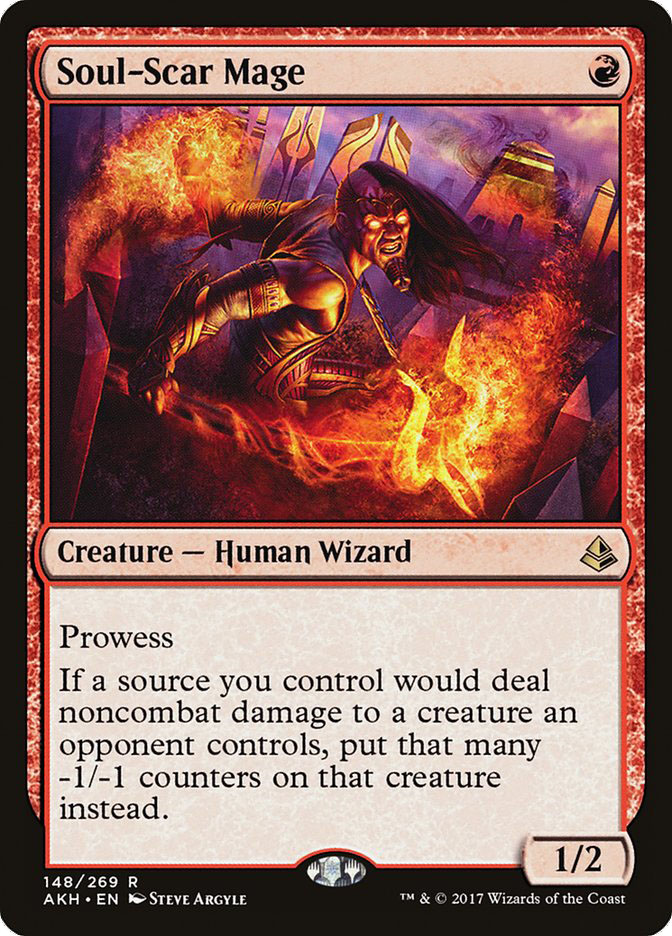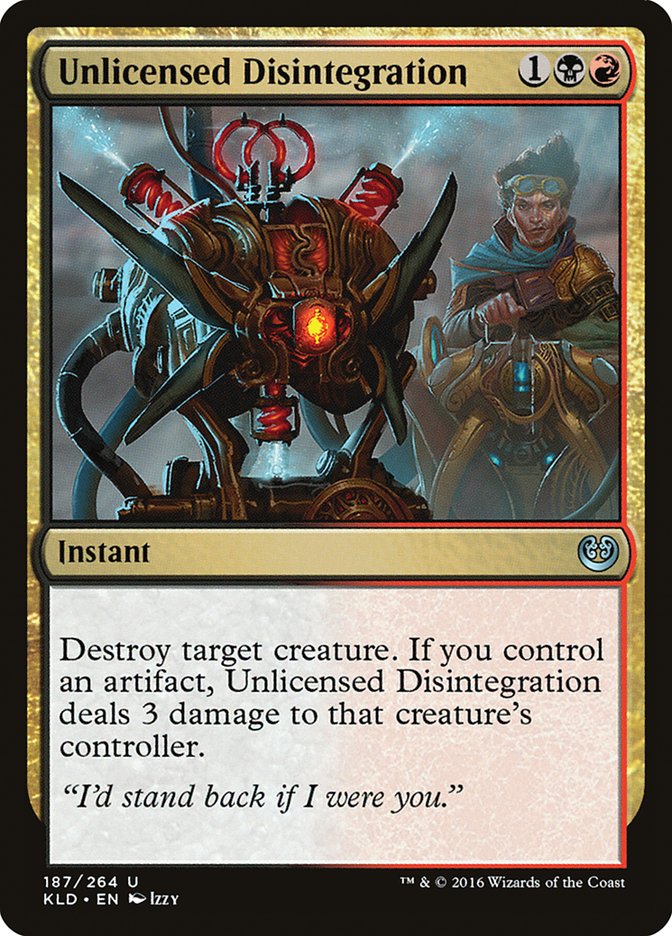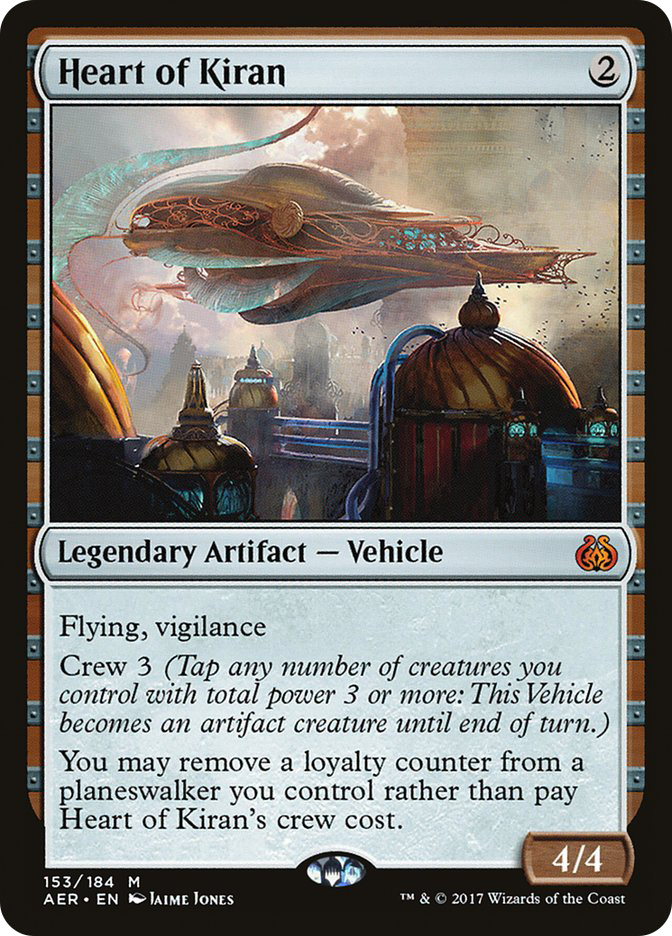This past weekend, I didn’t participate in a Magic tournament played in
real life, which is a very strange thing for me to say. I was looking at my
schedule, and I simply didn’t have any scheduled for May 11-13:
- GP Columbus (April 27-29)
- SCG Baltimore (May 5-6)
- GP Toronto (May 18-20)
- GP Washington DC (May 25-27)
- PT Dominaria (June 1-3)
- SCG CON (June 8-10)
- GP Las Vegas (June 14-17)
I told a friend about my upcoming schedule and he replied “that’s a lot of
equity coming your way,” which I appreciated, as that’s a positive outlook
and the affirmation made me feel great. What I did do with my time–besides
eat, sleep, and play Magic Online in my preparation for Pro Tour Dominaria– was watch some coverage of Grand Prix Birmingham, and
the results were something potentially very frightening.
Six copies of R/B Aggro in the top 8. That’s 24 copies of Goblin
Chainwhirler:
Creatures (19)
- 2 Pia Nalaar
- 4 Scrapheap Scrounger
- 2 Walking Ballista
- 2 Glorybringer
- 3 Soul-Scar Mage
- 2 Rekindling Phoenix
- 4 Goblin Chainwhirler
Planeswalkers (4)
Lands (25)
Spells (12)

Simon Nielson aka Mr Checklistcard (I’m sorry I don’t get the reference
there) seemed to slice through the tournament like a hot knife through
butter, winning almost every match that he decided to show up to. I try to
look at Glorybringer and Chandra, Torch of Defiance as ‘anti-G/B
Constrictor’ cards since they line up so nicely against most of the
creatures in that deck, they’re quite solid removal spells on the front
end, and they generate repeated advantage on the back end. It does hurt the
power of Chandra that its damage ability can no longer effect
planeswalkers, but it’s still a rock-solid threat against a control deck
and needs to be answered in a short time frame.
Nielson has just the right amount of sauce in game one with two
Glorybringer and two Chandra. You can look at these two like a four-of card
that’s a good topdeck and super powerful against creature decks, and he’s
got an extra Chandra and Glorybringer in the sideboard because sometimes
you just know your opponent’s deck is poorly positioned against these cards
and you want to exploit it.
I saw some Twitter drama recently talking about how unintuitive the
Planeswalker rules change is, and they’re absolutely right with these
gripes, but my position on it is this all just falls under the category of
growing pains. I love to see the people in charge of Magic trying to
improve the game and reevaluate rules that were made years ago to see if
they still provide the best experience for the players of the game. It’s a
little annoying to me because I can be forgetful about which cards do what,
but when it counts a few weeks from now at Pro Tour Dominaria,
I’ll be ready.
I must give credit where credit is due: Simon’s R/B Aggro list is a work of
art. It looks to have a diverse mix of threats that can have a huge impact
given the correct circumstances. One way I like to look at it is if a card
could potentially be a blowout in my favor, I like to have access to it so
my deck is capable of as many of the best hands as possible. My goal in
deck construction is to constantly push the power level of both my cards
and my deck to the max. Having one Release the Gremlins in the sideboard is
probably the best example of this since its power level scales dramatically
based on what your opponent is trying to do.
If your opponent has a 2/2 Walking Ballista and a Scrapheap Scrounger on
the battlefield, Release the Gremlins for two is a nice play but not nearly
as powerful since the opponent can simply use the Ballista counters to kill
the Scrounger, leaving Release the Gremlins countered due to a lack of
legal targets. Additionally, the Scrounger can exile the Ballista once
they’re both in the graveyard, so you don’t even generate card advantage.
This is a nice trick I like to use when I play against someone who I
suspect may have this card. If you play against someone who is a dedicated
artifact deck, Release the Gremlins can feel like Shatterstorm with upside.
Sometimes Constructed Magic really is that simple. If my opponent plays a
deck with all creatures, I want to be playing a deck with a few sweepers.
It’s easy to talk a big game, and to register a card that’s just a
stone-cold hate card against a small portion of the metagame can be a
gamble, but I respect it.
Soul-Scar Mage looks underpowered to me, but that may be a relic of my
preparation for Pro Tour Hour of Devastation where I played
Mono-Red Aggro. After a ton of testing, I concluded the card was simply
worse than Village Messenger. I didn’t like Village Messenger, but it was
just good enough to be worth including in the deck and many of my sideboard
plans involved removing it. I feel I was probably on the right side of
history, since the winning Mono-Red list from that Pro Tour had four
Village Messenger and zero Soul-Scar Mage.
Creatures (26)
- 4 Falkenrath Gorger
- 4 Village Messenger
- 4 Bomat Courier
- 3 Kari Zev, Skyship Raider
- 3 Hazoret the Fervent
- 4 Ahn-Crop Crasher
- 4 Earthshaker Khenra
Planeswalkers (2)
Lands (24)
Spells (8)

Soul-Scar Mage is not Monastery Swiftspear, and even if it was, it may not
be worth playing in these decks. I will freely admit that I may be
underestimating that synergy between Soul-Scar Mage and Goblin
Chainwhirler, which puts -1/-1 counters on all the opponent’s creatures
when Soul-Scar Mage is on the battlefield. I may also be underestimating
the amount of G/B Constrictor decks in the metagame which turns its ability
into a disadvantage causing the creatures to pick up two -1/-1 counters.
It’s possible a combination of factors allows Soul-Scar Mage to be a
passable maindeck inclusion, but my gut says that Nielsen only went with
three copies because drawing multiple is bad and it’s overall weak stats. I
don’t think this deck wants this type of card, but if you twisted my arm I
feel two is a fair place to land.
Unlicensed Disintegration is as hard to beat as it is to spell. I’ve spent
a few days pacing around my house talking to myself repeating over and over
that it’s one of the best cards in Standard. Week one of the format kind of
felt like Lyra Dawnbringer was the end-all be-all solution to competitive
play; you play it and you win. I believe the U/W Control contingent was
pretty much playing their strategy face-up declaring “I’m all about Settle
the Wreckage and Lyra Dawnbringer. Can you beat it?” and the players at GP
Birmingham decided “Yes, we can.”
Using Unlicensed Disintegration and Duress, you can beat these cards and
this strategy. It’s obvious U/W Control is no longer the best deck in
Standard and if that’s the deck you’re playing right now, you have to feel
like you’re on the backfoot. The good news is the games are rich with
interaction and the implications that a 3-8 card change in
maindeck/sideboard is much greater than we give it credit for. Changing a
few cards can have a drastic effect on the matchup, and even putting one
card (like maybe an Authority of the Consuls) could be enough to make their
beatdown strategy weak enough that you can prolong the game until the later
stages where your deck has inevitability. I’m surprised there aren’t more
Approach of the Second Sun decks being played.
Is two-mana for a Serra Angel a good deal? If so, why?
Heart of Kiran won the Magic Online PTQ and the GP in Birmingham. When will
its reign of terror end? I played it at Pro Tour Aether Revolt
where it was the best choice by a mile with six copies in top 8. I also
played it at Pro Tour Amonkhet where it was a decidedly mediocre
choice and you had to feel a little bit like a fool for not playing Temur
Aetherworks. It seems a little ridiculous to also give it vigilance when
Seal Away is the most played removal spell and cares about only two things,
being a creature and being tapped.
My final thought this week is that Llanowar Elves is the best card in
Standard alongside Toolcraft Exemplar (AKA Wild Nacatl). The problem is
that the most successful deck in Standard right now, R/B Aggro, is trying
to prey on the portion of the metagame which uses either card by killing
them for “free” with Goblin Chainwhirler and Walking Ballista. Llanowar
Elves and Toolcraft Exemplar are so good that the way to win in Standard is
to create an environment where they’re bad cards to draw.
It’s impressive to think that two cards have done just that.









